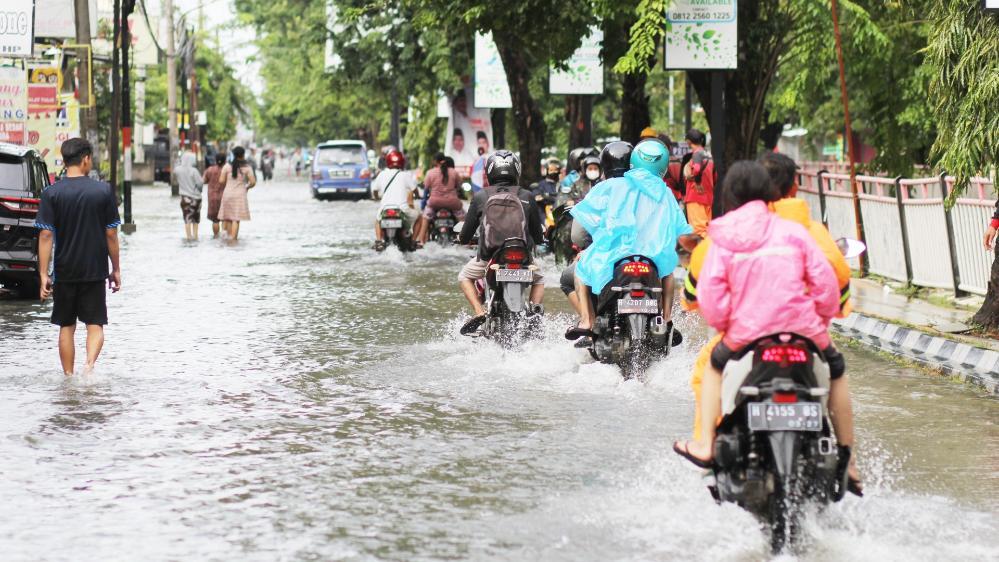October 3, 2023
UOW research to explore AI for flood mitigation in Indonesia
International team of researchers will incorporate machine learning and internet-of-things into tidal flood management systems to protect lives and infrastructure
The University of Wollongong (UOW), in partnership with Telkom University, Indonesia has received funding to digitally transform the monitoring of seawater levels across three cities in Central Java, bringing together leading experts in in artificial intelligence (AI), internet of things (IoT) and machine learning and environmental engineering from both countries, with far reaching impacts on the livelihoods of residents.
Daily tidal flooding poses a significant threat to the inhabitants of Central Java, Indonesia, with far-reaching consequences for people and the environment. Located in a low-lying coastal region, the cities of Pekalongan, Demak and Semarang are vulnerable to rising sea levels and extreme weather events. In May 2022, the cities experienced tidal floods reaching from 1.1m to 2m, causing 51 per cent of Pekalongan and many neighbourhoods of Semarang to be submerged.
The impact of tidal flooding is multifaceted. It endangers the safety of residents, leading to property damage, displacement, and even loss of life. The recurrent flooding disrupts daily life, places additional strain on emergency services and infrastructure, with considerable damage to roads, buildings, homes, public facilities, and drainage.
Residents of Pekalongan and Semarang experience adverse health consequences from the floods with moisture and mould related illnesses such as diarrhea, dengue fever, water fleas and skin and lung complaints on the rise.
Tidal flooding has detrimental effects on the region's economy and agriculture. Loss of productive land area has seriously affected the livelihood of 5 million residents across the three cities.
To mitigate the impact of tidal flooding, the Indonesian government has constructed seawalls, reservoirs, and massive pumping stations designed to pump water through the seawalls when the tidal level in the reservoir exceeds a certain threshold. Controlling the pumps is currently a manual process. The lack of continuous monitoring of sea levels and automation in controlling the water pumps results in poor accuracy, untimeliness, and low efficiency in responding to tidal floods and mitigating damages.
University of Wollongong Associate Professor Le Chung Tran will lead an international team of researchers to find solutions to digitally transform monitoring of sea levels and floods waters to improve the livelihoods of millions of people in the region.
“This project will develop a cutting edge, fit-for-purpose, scalable and affordable solution for tidal flood monitoring. It will help mitigate tidal flood losses, increase income, retain and enhance the livelihood of many local people. The project will also create a large shareable database for monitoring seawater and tidal floods. The program will include training for Pemali-Juana River Basin Office (BBWS) staff so that they can fully operate, maintain and replicate the system at other locations over the long term.”
The “Tide Eye” solution is an AI- driven system that incorporates drone technology and artificial intelligence-of-things (the combination of artificial intelligence technologies and the internet of things infrastructure.) The system will allow water infrastructure workers and residents in the three case cities to monitor seawater level and tidal flood risks in real time. This information will allow workers to make timely decisions to not only improve the efficiency of their flood mitigation infrastructure and reduce tidal flood impact, but also to partially prevent floods before they start.
“The applications of the project may extend far beyond the current scope – what we learn here through better tidal flood monitoring and flood prediction may result in better policies for mangrove planting and coastline management, housing, land use, transport and fisheries.
“In a world where climate change is increasing the number and severity of weather events, managing flood impact could be a challenge many countries must tackle. The outcomes of this project will be readily applicable to other end-users around the world. The solutions born out of this study will provide significant support for data driven decision making regarding climate change impact mitigations,” Professor Tran said.
ABOUT PROJECT PARTNERS
Funding for this project has been delivered by KONEKSI (Collaboration for Knowledge, Innovation, and Technology Australia and Indonesia) is Australia’s flagship program in the Indonesia knowledge and innovation sector funded by the Department of Foreign Affairs and Trade (DFAT) Australia.
The project brings together experts in AI, Machine Learning, IoT, and Environmental Engineering from University of Wollongong (UOW), Australia; Telkom University and PT Hilmy Anugerah Consulting Engineer Lt in Indonesia to transform the water monitoring at Pemali-Juana River Basin Office (BBWS).
UOW and Telkom University will be the lead Australian and Indonesian organisations, respectively.
BBWS is the manager of pump stations, seawalls, reservoirs, and water infrastructure.
PT. Hilmy Anugerah Ltd. will oversee advising on suitable locations, designing and constructing the footings and mounting structures of IoT stations, supervising the installation of equipment inland and in water areas, and providing logistics services.
